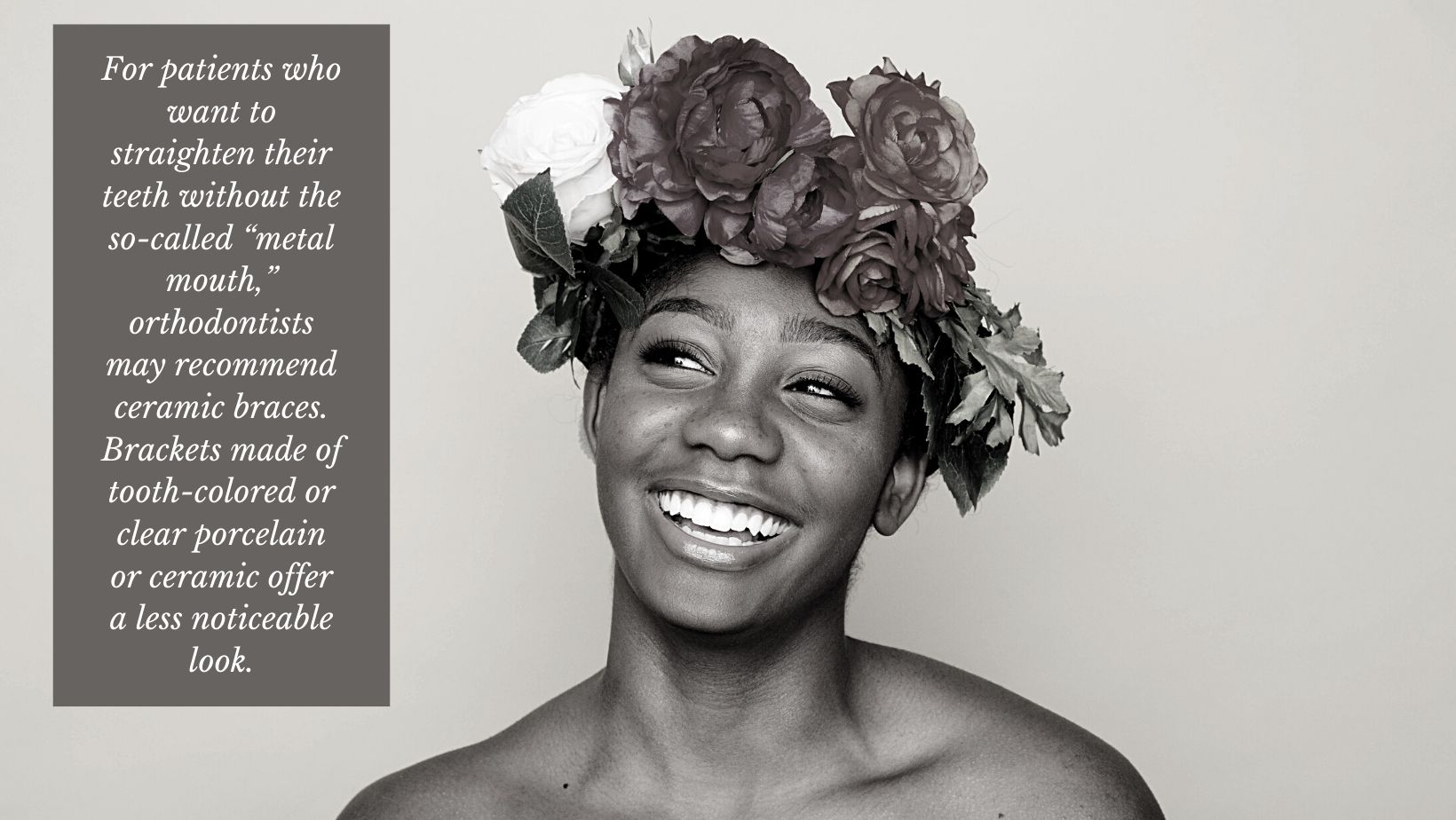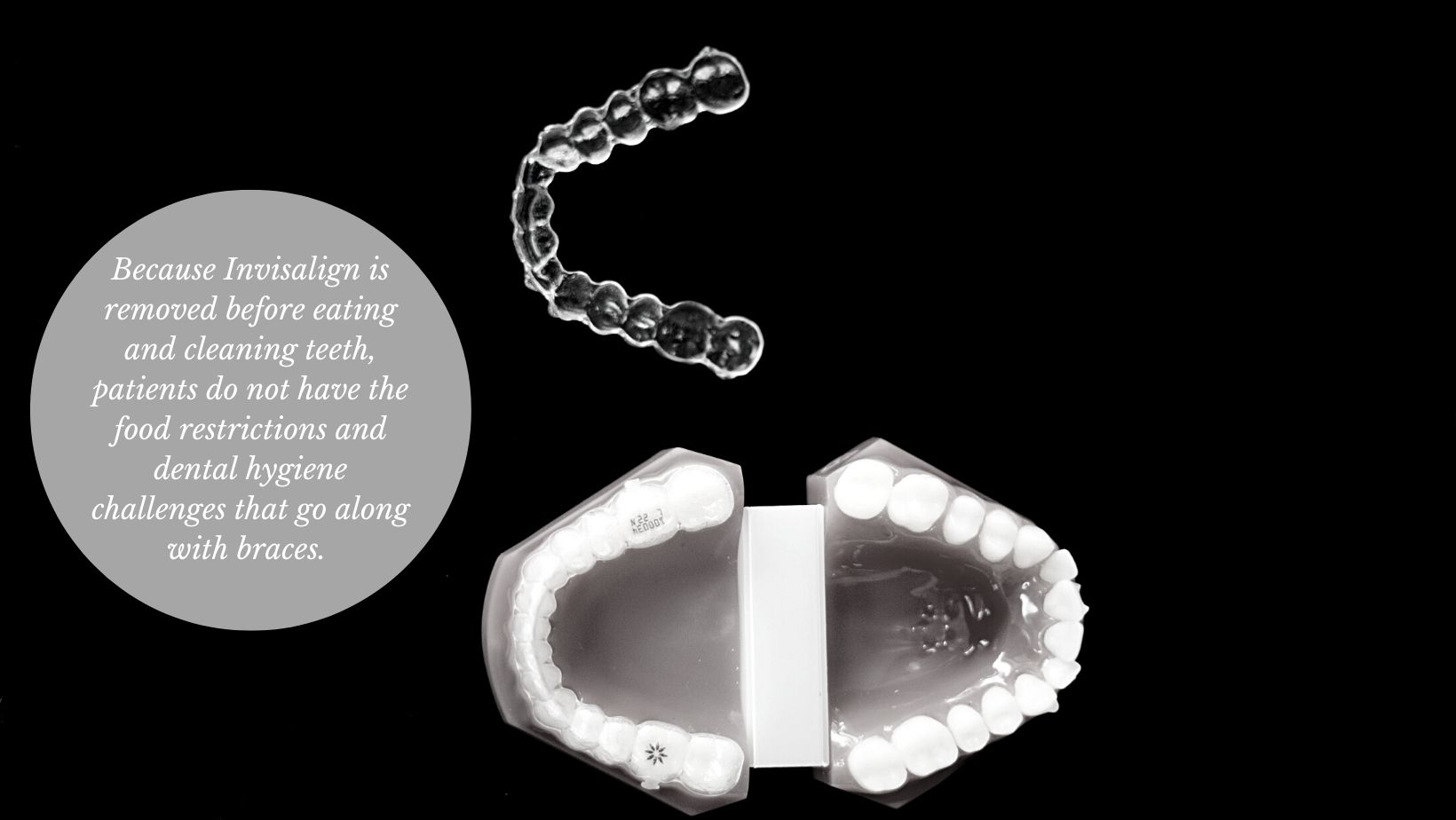The desire for straight teeth is nearly universal. For many years, the only option for correcting crooked teeth was metal braces. While braces are very effective, they are also very noticeable. These days, with new options available for straightening teeth, patients may wonder: are there any braces that are clear?
Whether for an image-conscious teenager or a professional in the public eye, there are a few orthodontic treatments that use less conspicuous, transparent materials. These include ceramic braces and clear plastic aligner trays like the popular Invisalign brand.
Clear Ceramic Braces
Braces help straighten teeth with brackets that are glued to each tooth. The brackets are connected by wires and often secured with tiny rubber bands. Some patients may also have metal bands placed around their back teeth. This system exerts gentle force on the teeth and surrounding jaw structure to reshape the smile. An orthodontist adjusts and tightens the wires every few weeks to gradually move the teeth into alignment. Braces are very effective for fixing most orthodontic issues, from minor to severe.
For patients who want to straighten their teeth without the so-called “metal mouth,” orthodontists may recommend ceramic braces. Brackets made of tooth-colored or clear porcelain or ceramic offer a less noticeable look. Sometimes the dentist can even use a tooth-colored or “frosted” wire to help the treatment blend in with the teeth even more.

Ceramic braces are much less noticeable than traditional metal braces, especially from a distance. Ceramic braces are just as effective as metal. They can correct overcrowding, close spaces between teeth, and help fix jaw issues like overbites and underbites. However, ceramic braces can be more delicate compared to metal and are more likely to break off or fracture. They may not be the best option for those who play rough sports, for instance.
Ceramic braces also cost more than metal ones. Some patients opt to use ceramic on their top teeth, which are more noticeable, and metal on the bottom arch to reduce costs.
Patients with braces need to take extra care to clean behind the wires and around the brackets, and they need to avoid chewing gum and hard and sticky foods. Patients with ceramic braces may also be advised to avoid foods and drinks that can stain the white brackets. These are not issues faced by patients using Invisalign as a clear braces alternative.
Clear Aligners: Invisalign, byte, and Others
While they are not braces, clear aligners are another transparent option for fixing crooked teeth. The most recognizable brand of clear aligners is Invisalign, though other options such as byte are available. To adjust teeth, Invisalign uses a series of removable plastic aligner trays. These are custom-engineered in a lab, based on putty impressions or digital images of the patient’s teeth.
The patient uses a new set of trays every couple of weeks. These progressively shift the teeth into alignment by applying a little bit of force. Each set of trays moves teeth a bit further. Invisalign trays fit over the teeth completely and don’t use any wires. In some cases, a patient might need tiny white attachments affixed to their teeth as part of their treatment plan. Even so, aligners are practically invisible except at very close distances.
Unlike braces, Invisalign trays are removable. Patients can—and should—take them out before eating and drinking anything but water. This also gives patients the option to remove them for a special moment, such as a photograph or important interview. However, to be effective, patients must wear their Invisalign trays for at least 22 hours a day. Wearing them for less than that makes them less effective and may increase the overall treatment time. And since they are removable, Invisalign trays can be misplaced. Replacing lost trays can be costly. For this reason, braces may be a better option for some, especially younger patients.
Because Invisalign is removed before eating and cleaning teeth, patients do not have the food restrictions and dental hygiene challenges that go along with braces. This is another reason for their popularity.
While braces require the expertise of an orthodontist, many general dentists offer Invisalign since the treatments are created in a lab. This might make finding a dentist to straighten your teeth easier.
Though Invisalign is less noticeable than ceramic braces, the clear trays are best for mild to moderate crookedness and gaps. For severe problems, braces are more effective. Invisalign also tends to cost more than ceramic braces.
Options for Clear Braces: Ceramic vs. Invisalign
Given the options, how do patients choose between ceramic braces and Invisalign for a clear orthodontic treatment? There are pros and cons to both in terms of treatment length, effectiveness, and cost, as well as the convenience of finding a practitioner. Ceramic braces are easier to notice and take longer, but they are less expensive and are effective for a wider range of cases. Invisalign is the most invisible option and can be faster than braces. And, patients can take out Invisalign trays for short periods of time, which helps with eating and hygiene issues as well as offering a respite for special moments.
| Appearance | Effectiveness | Treatment length | Convenience | Cost | |
| Clear ceramic braces | Clear, but noticeable up close. Fixed to teeth – not removable. | Very effective for minor to severe cases. Effectiveness not tied to patient compliance. | 18-24 months | Requires a trained orthodontist | More expensive than metal braces, less than Invisalign |
| Invisalign | Clear, less noticeable unless very close. Can be removed for short periods of time. | Better for less severe problems. Effectiveness depends on patient discipline to wear trays 22+ hours/day. | 6-12 months | Can be administered by an orthodontist or a general dentist | More expensive than braces |
Choosing a Clear Path Forward
When you are ready to move forward with a clear orthodontic treatment, a local dentist can help weigh the pros and cons. The best option depends on your or your child’s unique situation and needs. Use our online dentist search tool to get started today!



